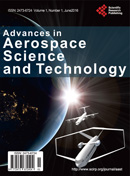Advances in Aerospace Science and Technology
Advances in Aerospace Science and Technology 航空航天科学与技术
ISSN Print: 2473-6708
ISSN Online: 2473-6724
Aims & Scope
Advances in Aerospace Science and Technology (AAST) is an open access journal. The goal of this journal is to provide a platform for researchers and practitioners all over the world to promote, share, and discuss various new issues and developments in all areas of Aerospace Science and Technology.
All manuscripts must be prepared in English and are subject to a rigorous and fair peer-review process. Generally, accepted papers will appear online within 3 weeks followed by printed hard copy. The journal publishes papers including but not limited to the breakdown of topics in 4 Dimensions: 1. Classification, 2. Life Cycle, 3. Usage, 4. Perspective. See below:
Dimension 1: Classification – Aeronautics, Astronautics, Aerospace Sciences
Aerospace is by definition broken down in Aeronautics and Astronautics. In addition different Aerospace Sciences have to be differentiated which have an application to both – air AND space.
Aeronautics
● Aircraft
o Manned Aircraft (powered)
§ Heavier than Air Vehicles
- Fixed Wing Aircraft (subsonic, supersonic, transonic and hypersonic)
- Rotorcraft (helicopter, autogyro, gyrodyne)
§ Lighter than Air Vehicles
- Airships (blimps and Zeppelins)
o Unmanned Aircraft (powered)
§ Unmanned Aerial Systems (UAS)
§ Missiles
o Unpowered Flight
§ Gliders
§ Kites
§ Balloons (moored and free)
o Human Powered Flight
o Animal Flight
● Aircraft Construction and Design
o Overall Aircraft Design (OAD)
o Airframe
§ Fuselage
§ Wing
§ Tail
§ Undercarriage
o Engines / Propulsion
§ Piston Engine
§ Turboprop
§ Turboshaft
§ Jet
o Systems
§ Avionics
- Aircraft Avionics
- Mission Avionics
§ Utility Systems
- Secondary Power Systems
- Protection Systems
- Cabin Systems
- Fuel Systems
- Flight Control Systems
- Landing Gear Systems
● Air Transportation
o Airport Planning, Operation, Management
§ Airside
§ Landside
o Airline Planning, Operation, Management
§ Fleet Planning
§ MRO Management and Spares Logistics
§ Flight and Ground Crew Management
§ Marketing
§ Airline Partnerships
§ Airline Finances
o Air Traffic Management (ATM)
§ Air Space Management (ASM)
§ Air Traffic Flow Management (ATFM)
§ Air Traffic Services (AIS)
- Air Traffic Control (ATC)
- Flight Information Service (FIS)
- Alerting Service (ALRS)
● Aeronautics and Society
o History of Aeronautics
o Aviation Law
o Aviation Accident and Incident Investigation
o Environmental Aspects of Aviation
Astronautics
● Spacecraft
o Launch and Reentry Vehicles
o Satellites
o Orbital and Mission Spacecraft, Space Stations
● Spacecraft Construction and Design
o Overall Spacecraft Design
o Structures
o Propulsion
o Systems
§ Astrionics
§ Utility Systems
§ Photovoltaics
o Payload
o Space Suits
● Spacecraft Operation
o Ground Infrastructure
o Space Infrastructure and Robotics
● Astronautics and Society
o History of Astronautics
o Space Law
o Space Debris
o Aerospace Philosophy (mostly space)
Aerospace Sciences (for Air and Space)
● Aircraft and Spacecraft Design
o Interior and Exterior Design
o Multidisciplinary Design Optimization (MDO)
● Materials and Lightweight Structures
o Strength of Materials and Structures
o Aeroelasticity and Structural Dynamics
o Manufacturing
● Fluid Dynamics and Thermodynamics
o Experimental and Numerical Aerodynamics (CFD)
o Thermal Management
o Acoustics
● Flight Mechanics and Flight Guidance
o Aircraft Performance
o Aircraft Stability and Controls
o Navigation
o Astrodynamics
o Flight Simulation
o Flight Testing
● Avionics and Mission Technologies
o Remote Sensing and Data Transmission
o Data Processing and Automation
o Software Engineering
● Sciences applied to Aerospace Systems
o Heating, Ventilation, Air Conditioning and Refrigeration (HVAC&R)
o Mechanical and Electrical Engineering
o Human Factors and Ergonomics (HF&E)
o Hydraulics and Pneumatics
o Kinematics
o Sanitation
● Systems Engineering and Management
o Air and Space Economics
o Security, Safety, Reliability and related Human Factors
o Project and Quality Management
o Airworthiness, MRO
o Documentation and Knowledge Management
● Air and Space Medicine
Dimension 2: Life Cycle
Aerospace products during their whole life cycle from research, development, design, production, operation, maintenance, repair, overhaul (MRO) up to end-of-life.
Dimension 3: Usage
Civil and military usage is considered for air and space. For e.g. aeronautics we consider:
● Civil Aviation
o General Aviation
o Scheduled Air Transport
o Non-scheduled Air Transport
o Experimental Aviation
o Model and Scaled Aircraft
● Military Aviation
o Combat
o Noncombat
Dimension 4: Perspective, Background, Economic Sector
Authors from all economic sectors are welcome. AAST papers should not only reflect a single background but eventually the whole spectrum of perspectives from all sectors. These sectors are:
● Private Sector
o Primary Sector: Extraction of raw material
o Secondary Sector: Manufacturing (Original Equipment Manufacturer, Tier One, Tier Two, ...)
o Tertiary Sector: Services (Operator, Maintenance Organization, ...)
● Public Sector
o State-Owned Corporation
o Government Agency
o Research Establishment
o University
§ Research
§ Teaching
● Civic Sector (NGO, NPO, ...)
● General Public (Passenger, Consumer, ...)
We are interested in:
● Original Research Papers.
● Comments where an author can present an idea with theoretical background but has not yet completed full research needed for an original paper, likewise a useful method, a small finding or discovery.
● Reviews in all aspects of Aerospace Science and Technology.
● Symposia or workshop papers published as supplements.
● Book reviews with comments and critiques.











